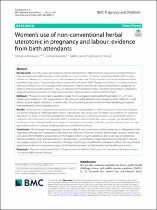| dc.contributor.author | Sumankuuro, Joshua | |
| dc.contributor.author | Baatiema, Leonard | |
| dc.contributor.author | Crockett, Judith | |
| dc.date.accessioned | 2022-08-05T12:17:06Z | |
| dc.date.available | 2022-08-05T12:17:06Z | |
| dc.date.issued | 2022 | |
| dc.identifier.citation | Sumankuuro, J. et al. (2022). Women’s use of non-conventional herbal uterotonic in pregnancy and labour: Evidence from birth attendants. BMC Pregnancy and Childbirth, 22(1), 600. https://doi.org/10.1186/s12884-022-04934-2 | en_US |
| dc.identifier.issn | 1471-2393 | |
| dc.identifier.uri | https://doi.org/10.1186/s12884-022-04934-2 | |
| dc.identifier.uri | http://hdl.handle.net/10566/7711 | |
| dc.description.abstract | Over the years, governments and stakeholders have implemented various policies/programmes to
improve maternal health outcomes in low-middle-income countries. In Ghana, Community Health Ofcers were
trained as midwives to increase access to skilled maternal healthcare. The government subsequently banned traditional birth attendants from providing direct maternal healthcare in 2000. Despite these, there is an unprecedented
utilisation of TBAs’ services, including herbal uterotonics. This has attempted to defeat stakeholders’ campaigns to
improve maternal health outcomes. Thus, we explored and highlighted herbal uterotonic consumption in pregnancy
and birth and the implications on maternal and newborn health outcomes in North-Western Ghana. | en_US |
| dc.language.iso | en | en_US |
| dc.publisher | BMC | en_US |
| dc.subject | Maternal and neonatal health | en_US |
| dc.subject | Pregnancy | en_US |
| dc.subject | Traditional birth | en_US |
| dc.subject | Herbal uterotonics | en_US |
| dc.subject | Ghana | en_US |
| dc.title | Women’s use of non-conventional herbal uterotonic in pregnancy and labour: Evidence from birth attendants | en_US |
| dc.type | Article | en_US |

